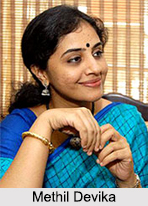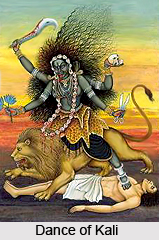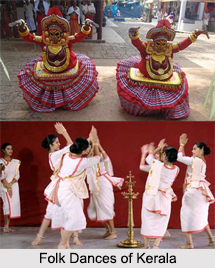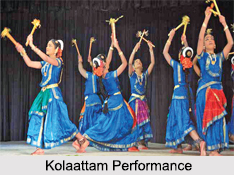 Folk dance of Nagaland forms the main component of the traditional culture of the people of Nagaland in India. Folk dances of Nagaland are performed mainly in a synchronized manner in groups by women as well as men, based on the kind of dance. Dances are generally performed in religious and festive occasions. Mainly the Naga men perform war dances. This dance is martial and athletic in style. All the folk dances of Nagaland are performed along with war cries and songs by the dancers. There are several folk dances in Nagaland which are generally performed at the time of harvest. The folk dances of this state are filled with frolic and fun since these dances are performed when the people of Nagaland are enjoying a special event. Each Naga tribe has its own dance, but they have a common feature. All the folk dances of Nagaland require the using of legs while keeping the body in an upright position.
Folk dance of Nagaland forms the main component of the traditional culture of the people of Nagaland in India. Folk dances of Nagaland are performed mainly in a synchronized manner in groups by women as well as men, based on the kind of dance. Dances are generally performed in religious and festive occasions. Mainly the Naga men perform war dances. This dance is martial and athletic in style. All the folk dances of Nagaland are performed along with war cries and songs by the dancers. There are several folk dances in Nagaland which are generally performed at the time of harvest. The folk dances of this state are filled with frolic and fun since these dances are performed when the people of Nagaland are enjoying a special event. Each Naga tribe has its own dance, but they have a common feature. All the folk dances of Nagaland require the using of legs while keeping the body in an upright position.
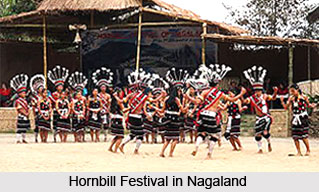
Popular folk dances of Nagaland
Nagaland has multiple tribes each having their own uniqueness, dance forms, cultures, language and more. For instance, some of the folk dances of Nagaland are Modse, Agurshikukula, Butterfly Dance, Aaluyattu, Sadal Kekai, Changai Dance, Kuki Dance, Leshalaptu, Khamba Lim, Mayur Dance, Monyoasho, Rengma, Seecha and Kukui Kucho, Shankai and Moyashai etc. However, the prominent ones are War Dance and Zeliang Dance.
Changsang dance
Changsang dance is a traditional folk dance performed by the Chang Naga Tribe of Nagaland during the Naknyulüm festival in the month of July. Changsang dance is performed in praise of the birthplace of mankind and therefore the earth.
Chang Lo/ Sua Lua
The Chang Lo Dance also referred to as "Sua Lua "is a traditional folk dance of the Chang Naga tribe of Nagaland. It was performed to celebrate the victory over enemies in the earlier times.
Monyu Asho
Monyu Asho dance is a traditional folk dance performed by the Phom Nagas during the festival Phom Monyu festival which is the biggest festival of the Phom Naga tribe. The festival is celebrated in April.
Melo Phita
Melo Phita dance is a traditional folk dance performed by the Angami Nagas during the Sekrenyi festival in the month of February. Sekrenyi festival is a purification festival observed for ten days.
Angushu Kighilhe
Angushu Kighilhe dance is a traditional war dance performed by the men folk of Sumi tribe.
Rukhyo Sharu
"Rukhyo Sharu" dance is a form of traditional folk dance performed by the Lotha Naga tribe. The word "Rukhyo Sharu" literally means "victory dance". It is performed during the head-hunting days to celebrate victory over the enemy.
Langnyu-Khiamtsangshe
Langnyu-Khiamtsangshe dance is a traditional folk dance performed by the Khiamniungan Naga tribe of Nagaland during the festivals of Miu and Tsokum, which are co-related to every other.
Akok-Khi
Akok-Khi is a dance form performed by the Sangtam tribe during the Mongmong festival.
Khupielilie
Khupielilie dance is a traditional folk dance performed by womenfolk of the Pochury Naga Tribe of Nagaland. This dance is an integral part of the Nazu festival of the Pochury tribe in the month of February. Khupielilie is a dance where women perform a major role.
Kukuyipheto
Kukuyipheto dance is a traditional folk dance performed by Chakesang Nagas. It"s an excellent choreography as the dance consists of fast and complicated footwork. This dance is performed during a grand feast referred to as "Feast of Merit" and administered by all the able-bodied men in full traditional attire.
Kulu-Tsen
Kulu-Tsen is a traditional Naga folk dance of the Yimkhiung tribe. Kulu means head, and Tsen means dance. It"s a dance associated with head-hunting.
Baimajai/ Plate Dance
Baimaijai dance is a traditional folk dance of the Dimasa tribe. The dance is performed by young girls or women with Plate or Dish. They perform the dance with two plates in both hands.
Udoho dance
Udoho dance is a traditional war dance of Angami Naga tribe. The literal meaning of Udoho is holding spear and shouting on enemy. It depicts the position of warrior in the village.
Nokinteker Tsungsang dance
Nokinteker Tsungsang dance is a Naga traditional dance form of the Ao Naga tribe. "Nokinteker" literally means "war hero".
